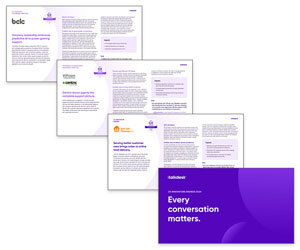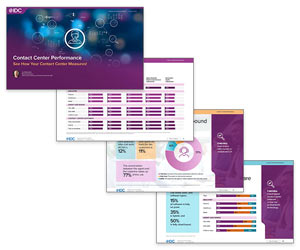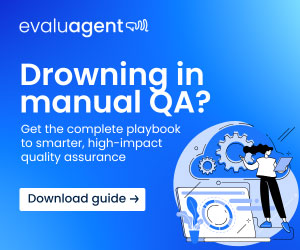As annoying as it can be for customers to prove who they are sometimes, verifying identity over the phone is crucial. In fact, it might be the single most important thing your contact centre does!
Getting it wrong can lead to serious problems like fraud, data breaches, and a complete erosion of customer trust.
With scams becoming more sophisticated, verifying who’s on the other end of the line is no longer just a box to tick – it’s a critical step you must complete every time to safeguard your business, protect your customers, and maintain your company’s reputation.
So, here’s some advice on how to get it right – in ways that protect all involved, whilst keeping the process smooth, respectful, and secure.
1. App-Based or Secure Messaging Channel Verification
If a customer calls from within your app (e.g. via a secure call or chat button), they’ve already been authenticated through the app’s login process – often using biometrics like fingerprint or face ID. This gives you a high level of certainty that the user is who they say they are.
WhatsApp and other secure messaging platforms can also be used for initial contact, where two-factor authentication (2FA) or in-app verification links can be sent before speaking live.
Pros:
- Customers are already verified by the time they speak to someone
- Easy and convenient for mobile-first users
- Strong encryption and security features
- Reduces time spent on authentication during the call
Cons:
- Only works for customers who’ve downloaded and logged into the app
- May exclude older or less digitally confident demographics
- Security still depends on the integrity of the user’s device
Best used when: Your audience is mobile-savvy and you want to combine customer service with streamlined, app-based access.
2. Single Verification Across Channels (No Repeats!)
Let’s say a customer passes verification in the IVR or with an agent, and then gets transferred to another department.
Rather than making them repeat the same process, your systems store a “verified” status or token that carries over – so other agents know the identity check has already been completed.
This can be done using CRM flags, call tracking metadata, or integrated case management systems.
Pros:
- Respects the customer’s time and effort
- Reduces frustration and repetition
- Helps agents pick up the conversation where it left off
Cons:
- Requires good integration across platforms and departments
- Needs clear internal policies on when and how to reverify
- If overused, may leave security gaps if not reviewed regularly
Best used when: You want to create a seamless, joined-up customer journey – especially for more complex or multi-step enquiries.
3. Manual Verification via Agent-Led Questions
With this method, a human agent asks the caller a set of predefined security questions. These are usually based on:
- Personal details (postcode, date of birth)
- Known transactions or account activity
- Memorable word or secret question
Good agents are trained to spot hesitation, inconsistent answers, or signs of deception – and to escalate suspicious calls accordingly.
Pros:
- Doesn’t require fancy tech – accessible for all budgets
- Flexible – agents can tailor questions to the situation
- Still a critical backup, even in tech-heavy contact centres
Cons:
- Prone to human error and social engineering
- Answers can be guessed or stolen (especially if data leaks occur)
- Slower and more intrusive for the customer
Best used when: You want a cost-effective, tried-and-tested method – but you’ll need strong agent training and policies in place.
4. AI-Powered Call Routing and Voice Biometrics
AI-powered contact centre systems such as Amazon Connect and Talkdesk use advanced technologies to enhance both call routing and caller verification.
For instance, Amazon Connect can analyse conversations in real time by picking up on sentiment, keywords, and compliance triggers.
Talkdesk, on the other hand, uses predictive routing to match callers with the most suitable agents based on past interactions and context.
Some of these systems also incorporate voice biometrics, analysing unique vocal traits like tone, cadence, and speech patterns. In some cases, the caller’s voice is compared to a stored “voiceprint” to verify their identity automatically.
Others focus on behavioural cues – such as hesitation, inconsistent answers, or signs of stress – and flag suspicious calls for further investigation.
Pros:
- High-tech, passive, and seamless for the caller
- Extremely difficult for fraudsters to fake voiceprints
- Reduces reliance on knowledge-based authentication (which can be leaked or guessed)
Cons:
- Can be expensive to implement and maintain
- Requires a large enough sample size to establish a trusted voiceprint
- Doesn’t always work well with accents, illness, or background noise
Best used when: You have the budget and scale to support AI, and want to future-proof your security process.
5. One-Time Passcodes (OTPs) and Secure Links
When customers are required to use a one-time passcode, it is sent to their registered mobile or email. The caller must read this code back or enter it into the system to proceed.
In other cases, a secure link is sent (e.g. for ID verification or account updates), which expires after a short time and can only be accessed by the intended recipient.
Pros:
- Highly secure – codes are single-use and time-limited
- Useful for high-risk or sensitive transactions
- Easy to integrate into digital journeys
Cons:
- Only works if contact details are up to date
- Can cause delays if customers can’t access their email or phone
- Still vulnerable if their inbox or phone has already been compromised
Best used when: You need an extra layer of protection for account changes, payments, or access requests – especially over phone or digital channels.
6. Automated Checks via IVR (Interactive Voice Response)
An interactive voice response (IVR) is an automated phone system that interacts with callers using voice prompts or keypad inputs, often used to collect information (like account numbers or dates of birth) before the caller is connected to a live agent.
When a caller first connects, the IVR system asks them to input identifying information – usually via the keypad or speech recognition.
This could include things like:
- Date of birth
- Account number
- Last digits of a payment method
- A PIN or memorable word
Advanced IVRs can even perform initial checks before a human gets involved, verifying against the customer record in your CRM or database.
Pros:
- Reduces call handling time
- Can be accessed 24/7
- Frees agents up to focus on more complex or sensitive tasks
- More secure than verbal questioning (less susceptible to social engineering)
Cons:
- May be frustrating for older customers or those less tech-savvy
- Not always suitable for customers with speech or hearing difficulties
- If the system fails to recognize input, it can loop and cause frustration
Best used when: You want a frictionless, front-loaded way to handle large call volumes while reducing agent workload.
7. CRM-Integrated Verification
If you have a customer relationship management (CRM) system, you can use it to automatically pull up a caller’s details – like their name, account history, and previous interactions – based on their phone number or ID input.
This allows agents to verify the caller more quickly and accurately, without relying on long lists of security questions.
When a call comes in, your telephone system pulls up the customer’s profile in your CRM using the incoming number (caller ID), IVR input, or a secure code. Agents can then verify the caller using known data – for example:
- Recent purchase history
- Past service interactions
- Registered address or email
This allows for more tailored, confident questioning and faster authentication.
Pros:
- Creates a seamless, personalized experience
- Reduces the need to ask blanket questions
- Gives agents more context to spot fraud or unusual behaviour
Cons:
- Only works if your CRM is regularly updated and accurate
- Caller ID spoofing is possible – so CRM matching should never be the only method
- Can lead to data silos if systems aren’t properly integrated
Best used when: You want to empower agents to make quicker, smarter decisions without relying solely on scripted security questions.
Fraud Is Getting Smarter by the Day
The goal of caller identity verification isn’t to trip customers up or make life harder – it’s to protect them (and you) in a world where fraud is getting smarter by the day.
The key is to find your perfect blend of human judgement and technology, including:
- One-and-done – Verify once and carry it through the journey
- Fit-for-purpose – Use what’s practical for your size, team, and customer base
- Proactive, not paranoid – Stay ahead of threats without punishing honest callers
Done right, verification becomes a quiet strength in your service experience – one that builds trust, loyalty, and confidence every time a customer calls.
If you are looking for more information and advice on improving contact centre security, read these articles next:
- 5 Examples of Contact Centre Fraud – and How to Prevent Them!
- Top Call Centre Security Challenges and How to Fix Them
Author: Stephanie Lennox
Reviewed by: Jo Robinson
Published On: 12th Aug 2025 - Last modified: 13th Nov 2025
Read more about - Customer Service Strategy, Compliance, Customer Service, Data Protection Act, GDPR, Security and Fraud, Service Strategy, Stephanie Lennox, Talkdesk, Top Story



















